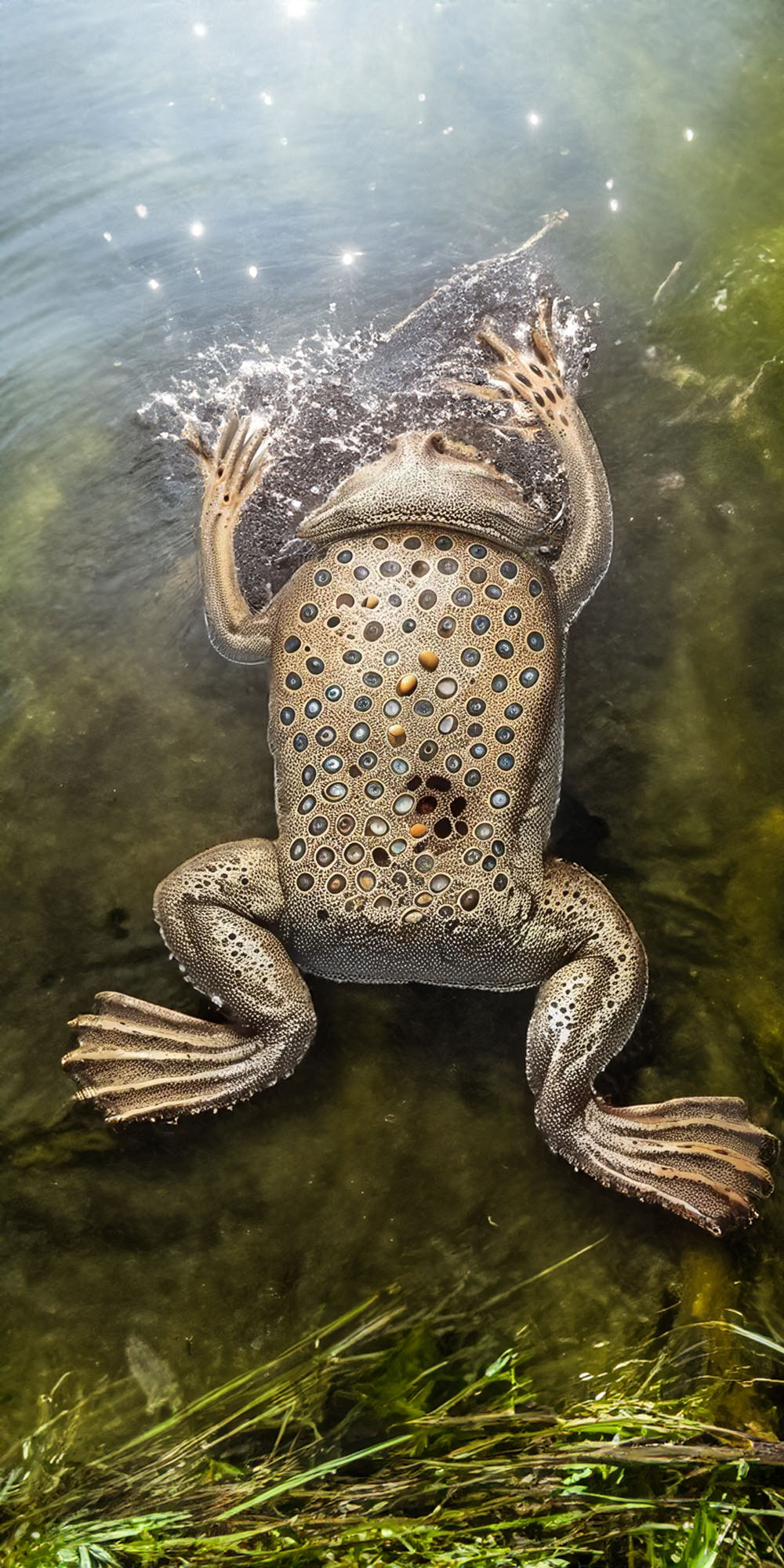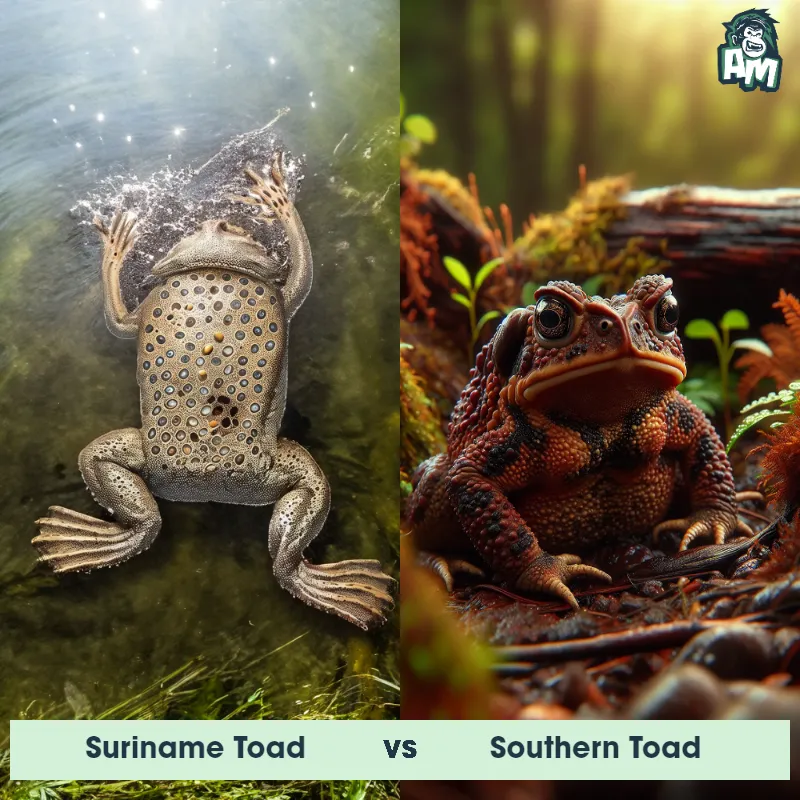The Suriname Toad
The Suriname Toad, also known as the Pipa pipa, is a fascinating amphibian native to the rivers and ponds of South America. It has a unique appearance with a flat, brownish body and a wide, flattened head. What sets this toad apart is its reproductive habits, as the female carries her eggs embedded in her back, where they develop into fully-formed toadlets before emerging. They are expert camouflagers, often blending in seamlessly with their surroundings.

| Suriname Toad | |
|---|---|
| Size | Approximately 4-6 inches (10-15 cm) |
| Weight | Around 4-6 ounces (113-170 grams) |
| Speed | 8mph (13km/h) |
| Key Strength | Adaptation for camouflage and defense through its unique appearance |
| Biggest Weakness | Slow-moving and vulnerable when out in the open |
| Scientific Name | Pipa pipa |
| Family | Pipidae |
| Habitat | Freshwater habitats such as ponds, slow-moving streams, and flooded forests |
| Geography | South America, particularly in countries like Suriname, Venezuela, and Brazil |
| Diet | Carnivorous, feeding on insects, small fish, crustaceans, and aquatic invertebrates |
| Lifespan | 10 years - 15 years |

The Suriname Toad
The Suriname Toad, also known as the Pipa pipa, is a fascinating amphibian native to the rivers and ponds of South America. It has a unique appearance with a flat, brownish body and a wide, flattened head. What sets this toad apart is its reproductive habits, as the female carries her eggs embedded in her back, where they develop into fully-formed toadlets before emerging. They are expert camouflagers, often blending in seamlessly with their surroundings.
Fun Fact: The Suriname Toad has specialized star-shaped bones in its fingers and toes that help it grip onto prey and climb trees in its aquatic environment.
| Suriname Toad | |
|---|---|
| Size | Approximately 4-6 inches (10-15 cm) |
| Weight | Around 4-6 ounces (113-170 grams) |
| Speed | 8mph (13km/h) |
| Key Strength | Adaptation for camouflage and defense through its unique appearance |
| Biggest Weakness | Slow-moving and vulnerable when out in the open |
| Scientific Name | Pipa pipa |
| Family | Pipidae |
| Habitat | Freshwater habitats such as ponds, slow-moving streams, and flooded forests |
| Geography | South America, particularly in countries like Suriname, Venezuela, and Brazil |
| Diet | Carnivorous, feeding on insects, small fish, crustaceans, and aquatic invertebrates |
| Lifespan | 10 years - 15 years |
Suriname Toad Matchups
We use AI to simulate matchups between the Suriname Toad and other animals. Our simulation considers size, strength, and natural predatory behaviors to determine the most likely outcome.

Can't find the Matchup you want?
Create Your Own MatchupSuriname Toad: Diet, Predators, Aggression, and Defensive Behaviors
What do Suriname Toads eat?
Suriname Toads are carnivorous amphibians that primarily feed on insects, small fish, crustaceans, and other aquatic invertebrates. They are known to be sit-and-wait predators, relying on their camouflage and stealth to ambush unsuspecting prey.
Do Suriname Toads have any predators?
While Suriname Toads do not have many natural predators due to their toxic skin secretions, they may occasionally fall prey to larger aquatic predators such as caimans, snakes, and birds of prey. Their unique appearance and defensive mechanisms help deter most predators.
Are Suriname Toads aggressive?
Suriname Toads are not typically aggressive towards other animals or humans. They are solitary creatures that prefer to stay hidden and avoid confrontations whenever possible. However, they may display aggressive behavior towards potential rivals during mating season.
Do Suriname Toads fight?
Suriname Toads are not known for engaging in physical fights with other animals. They rely more on their unique reproductive behavior, where males use their strong forelegs to compete for females in an underwater mating embrace. This behavior ensures successful fertilization of the eggs laid on the female's back.
How do Suriname Toads defend themselves?
Suriname Toads have developed several defense mechanisms to protect themselves from predators. Their skin secretes toxic substances that can deter potential threats. Additionally, their flat body shape and cryptic coloration help them blend in with their environment, making it difficult for predators to spot them.
What is a Suriname Toad's biggest weakness in a fight?
Despite their toxic skin secretions and camouflage, a Suriname Toad's biggest weakness in a fight would likely be their slow movement and lack of agility on land. As primarily aquatic creatures, they are better suited for stealthy ambushes in the water rather than engaging in physical confrontations on land.
Fun Fact: Despite their somewhat unassuming appearance, Suriname Toads are skilled ambush predators, using their excellent camouflage to blend in with leaf litter or mud while waiting for unsuspecting prey to come close.
Fun Fact: The skin of the Suriname Toad is peppered with tiny, warty bumps that help it blend into the murky waters it calls home, making it nearly invisible to predators and prey alike.












